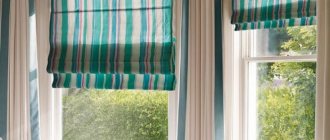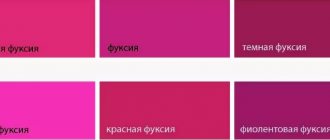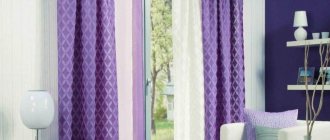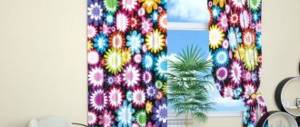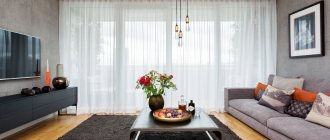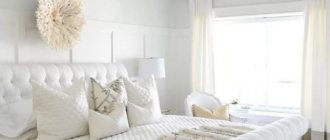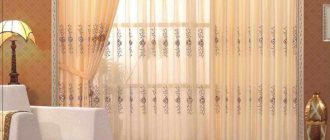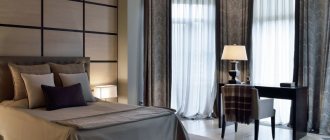Linen curtains in the interior of houses and apartments have regained popularity and found their place in modern design, despite the wide variety of products made from artificial fibers. Of course, synthetic fabrics have a wide range of colors and are more durable, but no artificial materials will give the room that feeling of cleanliness and comfort like linen curtains.
Advantages and disadvantages of linen curtains
Linen fabric is more difficult to care for and may not even be as durable as we would like. Nevertheless, linen in the interior has a number of advantages.
- Linen is 100% environmentally friendly material. This will be especially appreciated by fans of natural products and people with allergies.
- Linen curtains do not accumulate an electrical charge, so they will not collect dust and will remain clean and fresh longer. This advantage is important to consider when choosing curtains for a children's room.
- Linen curtains boast that they suit almost any room decor style.
- Curtains made from this material do not require a complex cut, since all the beauty and sophistication lies in the fabric itself.
Some may note that despite having such advantages, linen products also have many disadvantages. For example, that such curtains can shrink after washing. Here you need to know that all natural fabrics are soaked in hot water before sewing, the fabric shrinks and then sewing begins. Therefore, when buying a finished product, you don’t have to worry about its shrinkage at all. But if you decide to sew curtains yourself, keep in mind that it is better to soak the fabric first.
The second point that scares and “dissuades” the buyer: linen curtains wrinkle easily and are difficult to iron. Firstly, to wrinkle the curtains hanging on the window, you need to try very hard. Secondly, if you iron them immediately after washing while still wet, then no difficulties will arise.
Pros of linen curtains
If you want to purchase tulle from such a fabric, you need to understand its advantages. First of all, it is environmentally friendly, since the material is natural without any synthetic impurities. This is especially true if there are small children in the house. Such products are distinguished by natural beauty and elegance, since thanks to the amazing fabric, sunlight is diffused, which looks extremely original. Also, curtains made from this material will help create a stunning style for the room, which is why they are very often used by designers to decorate rooms.
You may also be interested in: Brocade fabric for curtains, types of fabric
Linen tulle is practical: it is easy to use and does not require special care. Curtains are easy to wash, they are less susceptible to contamination, are not susceptible to electrification, and can even remove the level of harmful radiation that comes from electrical appliances. made of linen fabric perform the function of a “natural air conditioner”, since in winter they warm the room, and in summer they fill it with coolness. Therefore, linen is widely used for summer curtains.
Linen fabric even has bactericidal properties, so it is often used to decorate windows in the kitchen, nursery or bedroom to maintain normal microflora in the rooms. Linen tulle will last for many years and will look like new. But linen has a small drawback - it is difficult to iron, so experts recommend using a steamer.
Variety of linen textiles
Types of linen fabrics can be divided into groups:
- By color: unbleached, dyed and bleached fabrics.
Unbleached canvases with a clearly defined weave resemble fabric woven by hand. It has a grayish color, sometimes almost brown or dirty yellow. Linen curtains of this color will perfectly decorate a “country” room or a modern apartment in the “Eco” style.
Dyed fabrics are more often used in office spaces and even in apartments. They are painted either with natural coloring pigments or synthetic dyes. When using bleach, such curtains can be irrevocably damaged.
Bleached linen is slightly lighter than unbleached linen, but not snow-white. It retains a light yellow or light brown hue.
- By density: dense and transparent. Curtains for the night are made from thick linen that does not allow light to pass through. But for daytime curtains, transparent material is suitable. It is woven from finer threads and has a loose weave.
- Texture: smooth and embossed. Embossed linen is woven from pure threads of different thicknesses, due to which irregularities and compactions appear in it. Curtains are made from this fabric. Smooth linen is used mainly for upholstery or for tailoring, but is also suitable for curtains.
- By fiber composition: pure and with impurities. Products made from pure fibers are subject to change in shape, but mixed fabrics, such as linen with the addition of lavsan, become smooth and wrinkle-free.
Linen curtains transparent
Thick linen curtains
How to choose linen curtains
When choosing linen curtains, you need to take into account the location of the curtains, whether they will hang all year round or change every season.
The choice of colors for curtains is varied:
- unbleached linen is available in taupe or dark gray shades. The fabric is popular when decorating interiors in a modern style.
Linen tulle with embroidery
- bleached products of various shades of white - ivory, baked milk, yellowish, light gray - the variety of shades is impressive
- dyed linen fabrics - as a rule, linen curtains are painted in natural colors - blue, azure, orange. Depending on the design ideas, curtains will add the necessary color.
Important! After washing, curtains shrink up to 7%, this must be taken into account when selecting. Linen wrinkles quickly, which gives the interior an unpresentable look, so you need to carefully ensure that they are ironed.
Depending on the functional purpose, the density of the curtains should be taken into account:
- light curtains are tulle, linen mesh is used independently or in addition to curtains. Gives additional volume to space, lightness, grace.
Linen curtains
- thick curtains - canvases with a relief structure are often used in living rooms or bedrooms for additional decoration and protection from prying eyes.
Fabric structure:
- pure linen is the most environmentally friendly, requires more care due to wrinkles
- with synthetic additives - they add additional shine and wear resistance. Silk gives smoothness, and lavsan makes the fabric less wrinkled
- metallized thread in the structure of linen fabric adds a special chic. The gold thread gives luxury, and the silver thread gives purity and space.
- linen tulle - can have a horizontal or vertical orientation of the fiber structure, which, accordingly, visually expands the space or makes it taller.
You might be interested in Description of leatherette: what the fabric is made of, features of the material
Linen with silk
The texture of linen fabric can be smooth or ribbed. The texture is achieved through patterns and the weaving of dense threads.
Note! White linen goes perfectly with blackout fabric. Airy white tulle can be complemented with fabric of a denser texture that does not allow light to pass through. The combination will be an excellent design solution for the bedroom.
Choosing a color for curtains
As we have already said in our other articles, the choice of curtain color depends on the entire interior composition. Will they overwhelm the room or go unnoticed? Everything again depends on the color schemes.
Curtains for the kitchen made of bleached linen in the same white interior will look gentle and elegant, but at the same time they risk going unnoticed. Therefore, if you want to make a bright accent in a bright room with curtains, choose colored fabrics.
You should also be careful with bright linen curtains. Dark wallpapers will refresh light curtains, and bright ones will clutter up the space, so we’ll leave them for light rooms. If the room has patterned walls, then the curtains should either have the same pattern or be plain to match the wallpaper. Curtains with a light, unobtrusive pattern will dilute boring plain walls.
Curtains in cold colors will give coolness to warm southern windows: blue, light blue or gray tones. The northern side will be warmed by warm shades: light yellow, pink, golden curtains.
Style solutions for linen curtains
Despite the simplicity of the material, linen curtains can be made in a wide variety of residential designs.
Scandinavian style. The name itself already means that the style is dominated by cold tones and a North Sea theme. Therefore, it is good to use bleached or grayish linen with a smooth texture here. On the contrary, dense material reminiscent of canvas fabric will create a Nordic atmosphere. Choose a print that will be combined with other decorative elements, for example: marine patterns, anchors, ropes.
High tech. The style of high technology and functionality does not interfere with the existence of natural textiles in it. Linen curtains in the interior of the living room can emphasize the minimalism that is inherent in high tech.
Provence and Country. Linen curtains in a rustic style will be predominantly yellowish in color with the presence of embroidery, lace and hemstitching. Such curtains will complete the interior with wooden furniture and other stylish decor. The density of the fabric is selected in accordance with the degree of illumination of the room.
Eco. For those who prefer an interior with natural materials, linen curtains will be a lifesaver. The color and density of the material will depend on the overall design theme and dominant elements. Most often, leather, stone, wood or cork material is used in such an interior.
Linen curtains: naturalness and richness of textures in the interior
Flax is an ancient plant used to produce high quality fabrics. The specific qualities of this plant base predetermine the high pricing policy of the products.
The fabric is quite rough and dense to the touch. Natural color ranges from muted white to light brown.
Artificial analogues, as a rule, are lighter, softer, and easier to dye. Therefore, dense, natural linen is “decorated” with lace, embroidery, and appliqué. Imitations of linen fabrics are dyed and also intensively decorated.
Main advantages:
- The fabrics are environmentally friendly and safe. They are suitable for interior decoration not only in the kitchen or living room, but also in the bedroom and children's room. Natural textiles do not cause allergic reactions. Eco style, which is clearly visible in curtains of this type, is ideal for complementing designs in rustic, country and Provence styles;
- The high cost of products is offset by the high level of wear resistance of textiles. Linen curtains will retain their original appearance for decades. Even numerous washes cannot deteriorate the aesthetic qualities of fabrics. This is especially true if the curtains will complement the interior design of the kitchen, hall or dining room;
- The canvases have a natural color, quite practical in everyday life. Creamy white, beige, gray, brown products are almost not subject to rapid contamination. Short, rolled, roman or eyelet - they are always perfect. Caring for the fabric is also easy; all stains can be washed off without the use of special cleaning agents;
- Modern linen curtains can be harmoniously combined with the most fashionable interiors for the kitchen, bedroom and other rooms. Curtains with grommets fit perfectly into the concept of Mediterranean and folk styles. Products decorated with lace will be a wonderful addition to the Provence style and Mediterranean interior. Roller and Roman linen blinds will become the basis for the Scandinavian style, light high-tech or original bio-tech;
- Linen is textured and flexible. Textiles can be given absolutely any shape. It looks impressive as minimalist short curtains, is beautiful in the Roman variation, roller blinds are organic, and models with grommets for the kitchen look impressive.

